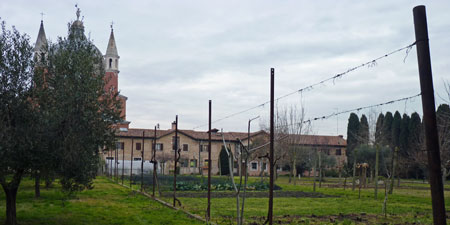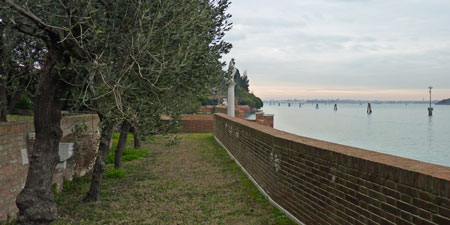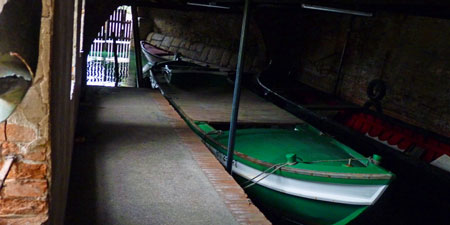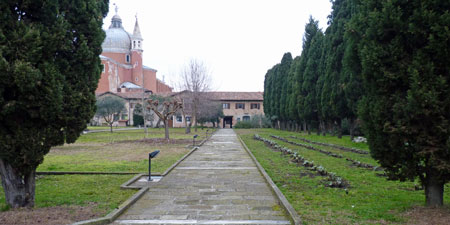 |
 |
||
 |
 |
CdP
1 February 2015
I had a very green time in Venice last week. I had been contacted by a lady from the Wigwam Club Giardini Storici who had seen something written by me in the Telegraph and hoped, I presume, for some mention of their garden tours in the future.
I had come across the name 'Wigwam Club' before, but had dismissed it as something frivolous: it's not the most inspiring moniker and it's amazing how often find I'm justified when I allow myself to be swayed by superficial considerations. In this case I definitely wasn't, however, because Mariagrazia and her colleagues are very serious about what they do, which is lead people around those wonderful, elusive, green bits you can feel all over Venice, their taller fronds poking out enticingly over high high walls, and the rest hidden from sight but somehow comfortingly vegetable in that most urban of cities.
Mariagrazia said she had seen a study claiming there are 500 gardens, and seemed surprised there were so many. I would be surprised if there were so few, though of course you'd have to define what you mean by 'garden' to reach any kind of consensus. There are odd patches of green – the kind of thing my imagination immediately labels 'potential garden' – in the most unlikely places. Take every one of these, and I reckon you're looking at more like 1000. Then again, that's just a wild guess.
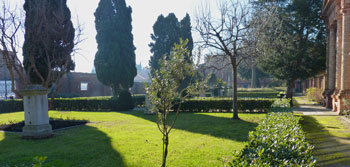
The Palazzo Contarini dal Zaffo, on Cannaregio's northernmost fondamenta Contarini, has been divided between two religious houses and its garden, which runs right up to the northern lagoon, has been split too, by a low-lying corridor along which – on the side Mariagrazia took me to – nuns zip on a bicycle. Running along the Sacca della Misericordia, the garden is a place of light and charm (though a recent revamp of the moorings in the sacca has filled that stretch of water with very aggressive-looking sharp-pointed red-painted briccole: locals, Mariagrazia said, now call it Fort Apache); its lay-out is modern and a little staid but full of roses in bloom and summer bedding it must be a pleasant enough place.
Way along at the northern end, another door jealously guarded by resident nuns, leads to the garden of the Casino degli Spiriti – a building I had often written about but never visited. Spiriti can mean ghosts, or wits. And the most likely origin for its name is in a group of artists and scholars – including Titian and the sonneteer Aretino – who met here in the 16th century, though its lonely position overlooking the San Michele cemetery island gives rise to any number of creepier stories. Nowadays ancient nuns are housed here, cushioned from reality by their lovely, ramshackle garden and peering out over their high walls, across the lagoon to the mainland with its snow-covered mountains. The spot is superb and this bit of green – with some inexplicable bits of masonry dotted around it and a fenced-in vegetable plot plus dilapidated sheds to one side – is truly lovely.
There's another surprise behind the Boscolo hotel on the fondamenta Madonna dell'Orto. This garden is a jungle, probably planted along English wilderness lines in the early 19th century. There's an artificial hill, with a strange beehive-shaped room below, a little bridge and tasteful Gothick ruins, and once again immense Celtis towering over the thick vegetation – and a view over the lagoon at the far end that will take your breath away.
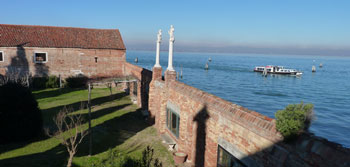
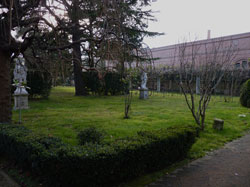
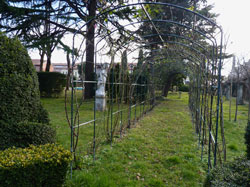
But it wasn't only Mariagrazia and her Wigwam Club that ushered me into private green spaces. L, for his article on the Giudecca that took us to the Lagoon city in the first place, talked to the artistic director at Fortuny. Then we strolled around the garden.
I love gardens in winter. Spring and summer are, of course, splendid with their flowers and verdure, but winter brings out the bone structure of the place, revealing all that's essential about it. So often here, water is the feature that encloses and defines. But it's also the length of gardens that makes them particular: long and relatively thin strips of land, generally with high walls on either side – very private places in a high-density urban space. Long and thin can be so tricky, and the typical Venetian garden does little to detract from or break up the slightly disorientating feel.
The Fortuny garden is no exception, though factory space poking into the garden gives it more variation and a swimming pool – one of very few in island Venice – is an alternative focus. There are walks and what must be lovely bloom-covered pergole in season. And statues and massive trees.
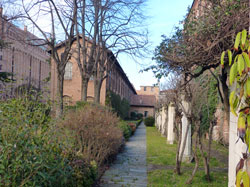
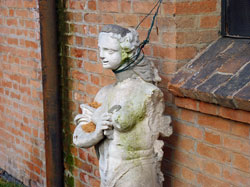
The garden behind the Redentore church, on the other hand, is long but also extraordinarily wide, occupying as it does a site that cuts from the Giudecca canal right out to the southern lagoon – slicing right across the island. I had done some curious peering into the southernmost part of the garden from the little public park – just around the corner from where C is now living and always empty. But being shown all around by the very earthy, leprechaunish Franciscan Padre Agostino, a man whose vocation seems to be to produce, was something very special.
Monks have been growing things here for centuries, and you can feel that. It's referred to as an orto but this is reductive: the growing areas aren't neatly structured or picturesque in any organised fashion, nor do they occupy the whole hectare-plus of land: the rows of olives are higgledy piggledy and the jujube trees are so old and gnarled you might mistake them, at a distance, for old vines (the vines have been pulled out for the moment). Patches of cabbages emerge from rough grass and large expanses of artichokes – the wonderful Venetian castraure type, eaten young and fantastically tender – do the same. There's the monk's superb cavana boat house and cypresses and long walks and areas – one walled off and one raised – for contemplation at the southern lagoon end. It's a place out of time, of utter tranquillity but also bursting with life.
